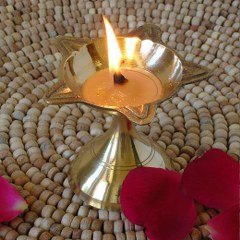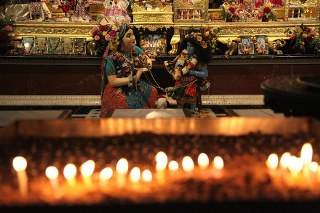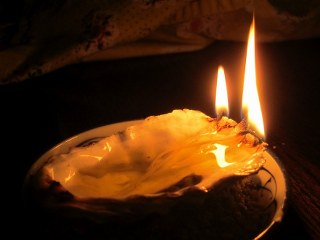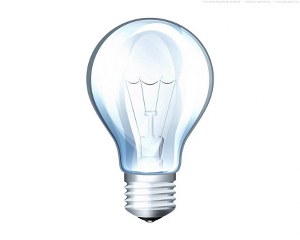Worship of a deity is a subject of faith for all of us. We build a temple room in our house and decorate it well. We also keep the images or idols of the deities we like and perform daily puja (ritualistic worship).We purchase the articles of puja according to our capacity.
We are also quite familiar with such articles like kalash (a water vessel generally of metal), shankh(conch ), a copper plate, a copper vessel, a small spoon, a lamp etc. Every article of puja has its own significance. Let us understand the significance of an important article of puja that is lamp.
1. Importance of lamp in Hindu Dharma
 The lamp has its own special place in Sanatan Vaidik Hindu Dharma. It is a form and a symbol of Tej (Absolute fire principle). The lamp is invoked as, ‘तमसो मा ज्योतिर्गमय ।’ meaning the lamp leads us from darkness towards light. It burns only to give message of peace and light to the man. This is its greatness. In this Satsang we shall try to understand what the scriptures have to say about the lamp. Amongst the articles of puja the lamp is an important article. The following mantra which is recited during the ritual of puja explains its significance.
The lamp has its own special place in Sanatan Vaidik Hindu Dharma. It is a form and a symbol of Tej (Absolute fire principle). The lamp is invoked as, ‘तमसो मा ज्योतिर्गमय ।’ meaning the lamp leads us from darkness towards light. It burns only to give message of peace and light to the man. This is its greatness. In this Satsang we shall try to understand what the scriptures have to say about the lamp. Amongst the articles of puja the lamp is an important article. The following mantra which is recited during the ritual of puja explains its significance.
भोदीपब्रह्मरूपस्त्वं ज्योतिषांप्रभुरव्यय: ।।
आरोग्यंदेहिपुत्रांश्चमत:शांतिं प्रयच्छमे ।।
Meaning: O Deity of lamp, you are of the form of Bramhan (the absolute truth). You are full of radiance. You never wither. Please bestow me health and good progeny and please fulfill my wishes.
2. Characteristics of Oil and Ghee lamps
Agni Puran clearly states that only oil or Ghee (clarified butter) be used in the lamp meant for puja and no other combustible substance. According to the Science of spirituality the lamp with clarified butter is more sattvik (spiritually pure) as compared to lamp in which oil is used. This is an important aspect which we will try to understand in details. So let us see the difference between the the lamp in which Ghee is used and the one with oil.
Generally the use of oil is more prevalent than that of Ghee. The oil containing lamp kindles longer while the ghee containing lamp kindles for a short period. Now let us see the difference from the spiritual view point.Ghee lamp has more capacity to attract the sattvik vibrations present in the surrounding atmosphere as compared to oil lamp.
The oil lamp can attract the sattvik vibrations spread over a maximum distance of 1 meter while the ghee lamp can attractsattvik vibrations spread over till Swarga Lok (heaven)
When the oil lamp stops burning the predominance of raja particles in the atmosphere is enhanced and lasts for half an hour. On the other hand when the ghee lamp stops burning the impact of sattvikta (the quality of being sattvik) on the atmosphere is experienced even after four hours.
Effects of Both Types of Lamp on the Worshipper.
 The oil lamp generates a subtle armour of inferior quality around the worshipper while ghee lamp generates a subtle armour of superior quality.
The oil lamp generates a subtle armour of inferior quality around the worshipper while ghee lamp generates a subtle armour of superior quality.
The subtle frequencies emitted from the oil lamp activate the Mind-energy (Manashakti) of the worshipper whereas the subtle frequencies emanating from the ghee lamp activates soul energy of the worshipper.
According to yogic path of Kundalini Yog there are seven principle chakras or energy centers in the human being. These chakrasinfluence practically every aspect of human being including physical body, mind and intellect. The oil lamp is effective in purification of Muladhar and Swadhishthan Chakra only to certain
extent but the ghee lamp purifies Manipur and Anahat chakrasto a significant extent.
Just as there are seven chakras in the human body, there are paths for the flow of vital energy (chetana). These are called asNadis or channels. The three principle nadis are Chandra nadi (Moon channel), Surya nadi (Sun channel) and Sushumna nadi.When Chandra nadi is active the person perceives coolness. The activation of Surya nadi imparts energy to the person. TheSushumna nadi is activated when the person starts progressing spiritually. The oil lamp activates the Surya nadi of the person while ghee lamp activates only that nadi which is essential to the worshipper in a particular action.
2.2 Effect on the Subtle Sheaths of the Worshipper
 According to the science of spirituality the body which is visible to our eyes is called Annamaya Kosha or food sheath. Besides this there are four other Koshas namely Pranmaya Kosha or vital air sheath, Manomaya Kosha or the mental sheath, Vidnyanmaya Kosha or sheath of intellect and Anandmaya Kosha or bliss sheath. The Pranmaya kosha is a seat for the Pancha pranas (five vital air elements) which provides energy to the gross body. The second Manomaya kosha is the seat of emotions.
According to the science of spirituality the body which is visible to our eyes is called Annamaya Kosha or food sheath. Besides this there are four other Koshas namely Pranmaya Kosha or vital air sheath, Manomaya Kosha or the mental sheath, Vidnyanmaya Kosha or sheath of intellect and Anandmaya Kosha or bliss sheath. The Pranmaya kosha is a seat for the Pancha pranas (five vital air elements) which provides energy to the gross body. The second Manomaya kosha is the seat of emotions.
The thirdVidnyanmaya Kosha is the seat of intellect and the fourth Anandamaya Kosha is the seat of Soul which is of the nature of existence, consciousness and bliss (satchidananda). Even these subtle sheaths or koshas are affected by the oil or ghee lamps. The oil lamp imparts power to the raja paricles in the Pranamaya kosha which makes the individual rstless. The ghee lamp strengthens the sattva particles of Pranamaya kosha and Manomaya Kosha and as a result of this the jiva (individual, embodied soul) becomes peaceful,stable and happy.
2.3 Spiritual Experience Imparted by Oil and Ghee Lamps
We are used to appreciating this world through the media of five sense organs namely nose, ears, eyes, tongue, skin , mind and intellect. This is known as experience. But when we experience something without the participation of all these then it is known as spiritual experience. Now let us compare the spiritual experiences obtained due to oil and ghee lamps. The oil lamp gives us spiritual experience of Pruthvi tattva (absolute earth element) and Aap tattva (absolute water element). For example if we get an experience of fragrance without the actual presence of an object which can impart such fragrance then it is a spiritual experience of Subtle fragrance or gandha. The fragrance is related to Pruthvi tattva. The example of spiritual experience of Aap tattva is dwelling sweet taste in the mouth.When we see subtle light or vision of a deity then it is an example of spiritual experience related to Tej tattva or absolute fire element. When we experience a feeling of touch without any external reason then it is a spiritual experience related to Vayu tattvaor absolute air element. The ghee lamp gives spiritual experience of Tej tatva and Vayu tattva to the worshipper.
2.4 Why Only Ghee Prepared From Cow’s Milk Should Be Used?
Generally any oil lamp emits frequencies consisting of raja particles but the sesame oil emits some sattva frequencies also. Therefore the lamp with sesame oil is comparatively more sattvik. However the ghee lamp emits the sattvik frequencies in maximum amount compared to any oil lamp. Here we have to remember one thing that it is useful use ghee prepared only from the cow’s milk in the lamp lit in front of Deity. This is because in such ghee the Deites’ principles are already existent. Such a ghee which is dominant in sattva component emits luminous figures in the atmosphere. Such luminous figures are forms of Tej tattva or absolute fire element. Thus even though the use of ghee is recommended because of its capacity to emit maximumsattva frequencies, we can use sesame oil lamp if the use of ghee is not possible because of financial restraints or otherwise.
2.5 Points To Be Considered While Using a Lamp
Do not kindle an oil lamp with a ghee lamp and vice versa. Do not kindle one lamp with another similar lamp. For example if there are two niranjans (a type of lamp) in an arti platter then do not light one niranjan with another niranjan. Similarly do not light one pillar of lamps with another.Sometimes while performing puja we unknowingly touch the lamp. We should immediately wash our hands then. This is because when we worship a deity the sattva component of the lamp increases. When we touch the lamp the raja-tamaparticles from our body enter the lamp by way of touch. This reduces the purity of the lamp. The water has the property of encompassing everything. Anything which is offered to a deity through the medium of water reaches Him/Her faster.
When we wash our hands we are one way dissolving our sins in the water. The spiritual practice of water is to assimilate in itself sins done by all. The extremely merciful Deities absolve us from our defects when we offer them at their feet through the medium of water.
3. Should Electric Bulbs Be Used Instead of Ghee Lamps?
 Now a days we see electric bulbs in use during the puja ritual instead of ghee lamp. What is the difference between two from the point of view of Spiritual science?Some people may be finding it funny to worship a lamp of oil or ghee when the modern scientific era has offered us so much glitter by way of electrical bulbs. But our ancestors have given priority to the worship of lamp after profound experience and through the attitude of gratitude. Let us now compare the electrical bulb and the lamp with ghee. The light emitted from the electrical bulb blinds our eyes while the gentle flame of ghee lamp reminds us of Atma-Jyoti or flame of soul. The electrical bulb makes us extroverted and then the mind runs towards external objects. The ghee lamp makes us to look inwards. Thus we have seen the difference between the electrical bulb and ghee lamp.
Now a days we see electric bulbs in use during the puja ritual instead of ghee lamp. What is the difference between two from the point of view of Spiritual science?Some people may be finding it funny to worship a lamp of oil or ghee when the modern scientific era has offered us so much glitter by way of electrical bulbs. But our ancestors have given priority to the worship of lamp after profound experience and through the attitude of gratitude. Let us now compare the electrical bulb and the lamp with ghee. The light emitted from the electrical bulb blinds our eyes while the gentle flame of ghee lamp reminds us of Atma-Jyoti or flame of soul. The electrical bulb makes us extroverted and then the mind runs towards external objects. The ghee lamp makes us to look inwards. Thus we have seen the difference between the electrical bulb and ghee lamp.
4. Five Wicks and Single Wick Lamp
There are other varieties of the lamps also such as lamp with a single wick and lamp called niranjan wherein five wicks are used. The Niranjan with five wicks is symbolic of duality that is the manifest energy of a deity, whereas the lamp with a single wick attracts sattvik frequencies the lamp with five wicks attracts waves with destroyer property and dominant in raja component. Theniranjan with five wicks denotes the relation of Panchpran (five vital air principles) with the Atmajyoti (flame of soul). Niranjan is used for waving Pancharati. Every single flame of niranjan is symbolic of Atmajyoti. Pancharti means invocation of God with the help of panchparanas.While performing Pancharti we should have such a spiritual emotion that the Atmajyoti is kindled in me with the help of five panchaprans present in the body and I am performing the arti with such flame.
5. Why Should a Straight Wick be Used as Compared to Puffed Up Wick?
During puja ritual a lamp is offered at various steps of the ritual according to purpose. For example performance of arti. Two types of wicks are used in the lamp namely Puffed wick and straight wick. Nowadays a puffed wick is used in a ghee lamp or niranjan and used as lamp of worship. The wick is puffedup from below to offer it stability to stand in the center of niranjan. The puffed wick is used in a ghee lamp. This type of wick is relatively of recent origin.The second type of wick which we all are familiar with is straight wick. Two straight wicks are joined together like a thread and used in a lamp. Not only there is difference between the two on a gross form but also on spiritual level.
- The lower portion of the fulwat is puffed up while the straight wick is whole like a thread.
- The fulwat is representative of various raja thoughts in the mind while straight wick is symbolic of detachment and also represents the thread which joins Panchaprans with Atamjyoti.
- When a fulwat is kindled the inferior deities are attracted to it while the straight wick when kindled attracts principles of higher deities.
- The frequencies emitted by the fulwat are of circular form while those emitted by straight wick are in the form of waves.
- The colour of the divine consciousness emitted by the fulwat is redish yellow while that emitted by straight wick is of yellow colour.
- Sattvik earth frequencies get attracted towards fulwat while more sattvik frequencies moving in the upward direction are attracted towards straight wick.
- The atmospheric frequencies get momentum due to fulwat while their momentum is slowed down by the use of straight wick.
An armour of Pruthvi (absolute earth element) and Aap tattva (absolute water element) is generated around the worshipper by use of fulwat while straight wick generates an armour of Tej tatva (absolute fire element) around the worshipper.
According to science of spirituality Tej tattva is more powerful than either Pruthvi tatva or Aap tattva. As a result the use of fulwatimparts heaviness to the physical body while the use of straight imparts cheerfulness to mind.